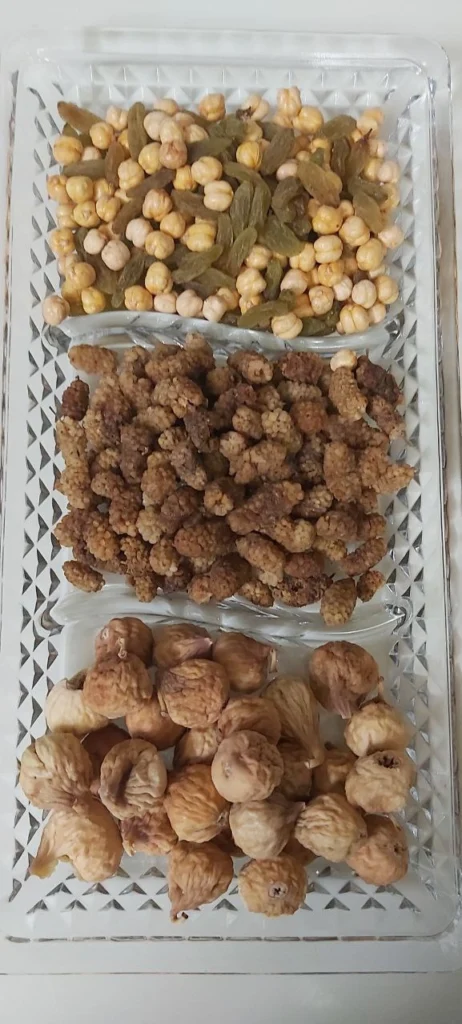The Comprehensive Guide to Healthy Snacks and Dried Fruits: Raisins, Roasted Chickpeas, Dried Figs, and Dried Berries

The Comprehensive Guide to Healthy Snacks and Dried Fruits: Raisins, Roasted Chickpeas, Dried Figs, and Dried Berries
In today’s fast-paced world, finding healthy and nutritious snack options can be a challenge. But what if I told you that a treasure trove of health and energy is hidden within nature itself? Yes, we’re talking about dried fruits and nuts – these small, delightful snacks that, through the drying process, preserve their flavor, aroma, and nutrients, transforming into a powerhouse of vitamins, minerals, and fiber. In this article, we will explore four beloved members of the dried fruit family: raisins, roasted chickpeas, dried figs, and dried berries, along with their unique benefits and the proper drying methods that help us enjoy these divine gifts in the best quality.
1. Raisins: Natural Sweetness with Sustained Energy
Raisins, obtained from drying grapes, are one of the oldest and most consumed dried fruits globally. These dried grapes come in various colors and flavors, from golden raisins and sultanas to Zante currants (small, dark dried grapes).
Benefits of Raisins:
- Instant Energy Source: The natural sugars in raisins, such as fructose and glucose, provide a quick source of energy, making them an ideal snack for athletes and those needing a rapid energy boost.
- Rich in Fiber: The fiber content in raisins aids digestive health, promotes satiety, and helps regulate blood sugar levels.
- Potent Antioxidants: Raisins contain phenolic compounds that act as antioxidants, fighting free radicals and thus protecting cells from damage, reducing the risk of chronic diseases.
- Essential Minerals: Raisins are a good source of potassium, iron, and copper. Potassium helps regulate blood pressure, iron is crucial for preventing anemia, and copper plays a role in red blood cell formation.
- Bone Health: The boron found in raisins aids in the better absorption of calcium and magnesium, contributing to bone health.
Proper Drying Method for Grapes (Raisins):
The traditional sun-drying method is the most common and economical. Ripe, healthy grapes are washed and spread on clean cloths or mats in direct sunlight. This process takes several days to a week, depending on temperature and humidity. The grapes should be regularly turned to prevent mold and ensure even drying. Another method involves using specialized dehydrators with controlled temperatures (usually 104-122°F or 40-50°C) and airflow, which speeds up the process and ensures better quality.
2. Roasted Chickpeas: Plant Protein and Fiber in a Small Package
Roasted chickpeas, essentially dried chickpeas, are a nutritious legume also consumed as a snack. Their nutty flavor and crunchy texture make them a popular choice alongside other dried fruits or on their own.
Benefits of Roasted Chickpeas:
- Rich Source of Plant-Based Protein: Chickpeas are an excellent source of protein, vital for building and repairing body tissues, especially for vegetarians and vegans.
- High in Fiber: Like raisins, chickpeas are packed with dietary fiber, promoting long-term satiety, regulating blood sugar, and supporting gut health.
- Important Minerals: Chickpeas contain iron, magnesium, phosphorus, and zinc, each playing a crucial role in various bodily functions.
- Aids in Weight Management: Due to their high protein and fiber content, chickpeas can increase feelings of fullness, helping to control appetite and manage weight.
- Heart Health: The fiber and potassium in chickpeas help lower bad cholesterol (LDL) and regulate blood pressure, improving heart health.
Proper Drying Method for Chickpeas (Roasted Chickpeas):
Chickpeas are typically consumed as roasted chickpeas, often after boiling. Dried chickpeas are soaked for several hours and then boiled until tender. After draining, they are spread on baking sheets. While they can be sun-dried, using food dehydrators at low temperatures (around 120-140°F or 50-60°C) is preferable for preserving quality and preventing contamination. They are dehydrated until they achieve a crisp texture.
3. Dried Figs: Natural Sweetness with Abundant Fiber
Dried figs, derived from the fig fruit, are among the sweetest and most nutritious dried fruits. Their caramel-like flavor and soft, chewy texture make dried figs a delightful snack option or an addition to desserts and breakfasts.
Benefits of Dried Figs:
- Natural Laxative: Due to their high fiber content and sorbitol, dried figs act as a natural laxative, helping to relieve constipation and improve bowel function.
- Calcium and Potassium: This dried fruit is a good source of calcium for bone health and potassium for regulating blood pressure.
- Antioxidants: Dried figs contain antioxidants like Vitamin C and E, which help combat oxidative stress.
- Natural Sugars: The natural sweetness of dried figs makes them a healthier alternative to artificial sweeteners.
- Skin Health: The vitamins and minerals in dried figs can contribute to radiant and healthy skin.
Proper Drying Method for Figs:
Figs are harvested when fully ripe and sweet. They are gently washed and spread on special drying trays. Sun-drying is common, but care must be taken to ensure even exposure to sunlight and protection from dust and insects. For sun-drying, figs are often halved to speed up moisture removal. In industrial or home dehydration, temperatures around 120-140°F (50-60°C) are used for several hours until the figs are pliable and chewy.
4. Dried Berries: A Delightful Taste with Antioxidant Benefits
Dried berries, made from drying various berries like mulberries, blackberries, and strawberries, offer a sweet and slightly tart flavor, with their attractive colors adding beauty to meals.
Benefits of Dried Berries:
- Potent Antioxidants: Berries, especially mulberries and strawberries, are rich in anthocyanins and Vitamin C, providing powerful antioxidant properties that help protect the body against cellular damage.
- Fiber and Vitamins: Dried berries are a good source of fiber, Vitamin K, Vitamin C, and manganese.
- Brain Health Support: The antioxidants in berries may contribute to improved brain function and memory.
- Blood Sugar Regulation: Some studies suggest that the fiber and compounds in berries can help regulate blood sugar levels.
- Skin Health: Vitamin C in dried berries is essential for collagen production and skin health.
Proper Drying Method for Berries:
Berries are harvested at peak ripeness and gently washed. For drying, they can be spread whole or halved on trays. Sun-drying is a traditional method requiring several days. Using a food dehydrator at low temperatures (around 104-122°F or 40-50°C) is recommended, as this temperature helps preserve the color, flavor, and nutrients of the berries. The drying process should continue until the berries are leathery and chewy but not completely brittle.
Important Notes on Storing Dried Fruits:
To maintain the quality and prevent spoilage of dried fruits, store them in airtight containers in a cool, dry place, away from direct sunlight. Using vacuum-sealed bags or dark glass containers will extend their shelf life.
Conclusion:
Raisins, roasted chickpeas, dried figs, and dried berries are just a few examples of nature’s nutritious treasures that can contribute to our well-being with regular and informed consumption. By understanding their benefits and adhering to proper drying and storage techniques, we can ensure these delicious and healthy snacks are always available to us, allowing us to reap their countless benefits. So, let’s choose these natural gifts over processed snacks filled with additives and gift ourselves good health!
